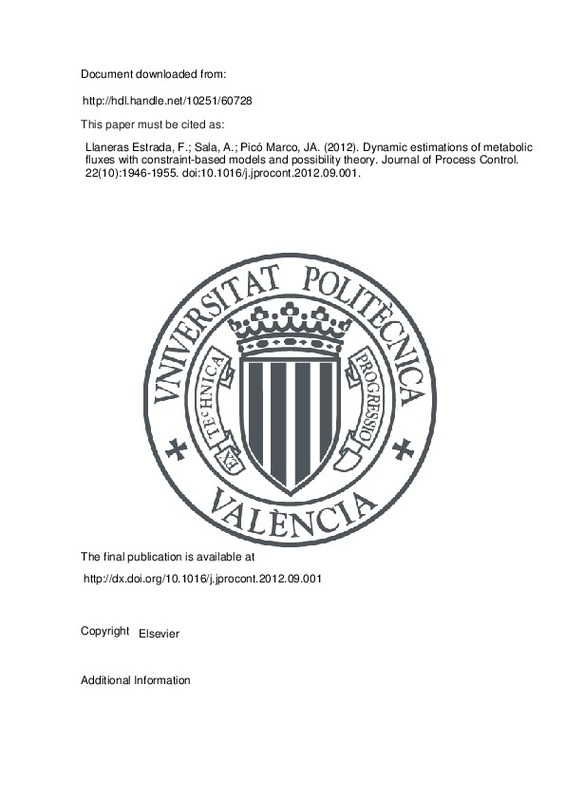JavaScript is disabled for your browser. Some features of this site may not work without it.
Buscar en RiuNet
Listar
Mi cuenta
Estadísticas
Ayuda RiuNet
Admin. UPV
Dynamic estimations of metabolic fluxes with constraint-based models and possibility theory
Mostrar el registro sencillo del ítem
Ficheros en el ítem
| dc.contributor.author | Llaneras Estrada, Francisco
|
es_ES |
| dc.contributor.author | Sala, Antonio
|
es_ES |
| dc.contributor.author | Picó Marco, Jesús Andrés
|
es_ES |
| dc.date.accessioned | 2016-02-09T09:32:18Z | |
| dc.date.available | 2016-02-09T09:32:18Z | |
| dc.date.issued | 2012-12 | |
| dc.identifier.issn | 0959-1524 | |
| dc.identifier.uri | http://hdl.handle.net/10251/60728 | |
| dc.description.abstract | Living cells can be modelled by successively imposing known constraints that limit their behaviour, such as mass balances, thermodynamic laws or enzyme capacities. The resulting constraint-based models enclose all the functional states that the modelled cells may exhibit. Then, predictions can be obtained from the models in two main ways: adding experimental data to determine the state of cells at given conditions (MFA) or invoking an assumption of evolved optimal behaviour (FBA). Both MFA and FBA predictions are typically performed at steady state. However, it is easy to take extracellular dynamics into account. This work explores the benefits of using possibility theory to get these dynamic predictions. It will be shown that the possibilistic methods (a) provide rich estimates for time-varying fluxes and metabolite concentrations, (b) account for uncertainty and data scarcity, and (c) give predictions relaxing the optimality assumption of FBA. On the other hand, these methods could serve as basis for monitoring and fault detection systems in industrial bioprocesses. | es_ES |
| dc.description.sponsorship | This research has been partially supported by the Spanish Government MINECO (1st and 3rd authors are grateful to grant CICYT DPI2011-28112-C04-01, and A. Sala is grateful to grant DPI2011-27845-C02-01). | en_EN |
| dc.language | Inglés | es_ES |
| dc.publisher | Elsevier | es_ES |
| dc.relation.ispartof | Journal of Process Control | es_ES |
| dc.rights | Reserva de todos los derechos | es_ES |
| dc.subject | Constraint satisfaction problems | es_ES |
| dc.subject | Possibility theory | es_ES |
| dc.subject | Constraint-based model | es_ES |
| dc.subject | Metabolic flux analysis | es_ES |
| dc.subject | Flux balance analysis | es_ES |
| dc.subject.classification | INGENIERIA DE SISTEMAS Y AUTOMATICA | es_ES |
| dc.title | Dynamic estimations of metabolic fluxes with constraint-based models and possibility theory | es_ES |
| dc.type | Artículo | es_ES |
| dc.identifier.doi | 10.1016/j.jprocont.2012.09.001 | |
| dc.relation.projectID | info:eu-repo/grantAgreement/MICINN//DPI2011-27845-C02-01/ES/ESTIMACION, OPTIMIZACION Y CONTROL MULTIVARIABLE EN SISTEMAS MULTI-MODELO/ | es_ES |
| dc.relation.projectID | info:eu-repo/grantAgreement/MICINN//DPI2011-28112-C04-01/ES/MONITORIZACION, INFERENCIA, OPTIMIZACION Y CONTROL MULTI-ESCALA: DE CELULAS A BIORREACTORES/ | es_ES |
| dc.rights.accessRights | Abierto | es_ES |
| dc.contributor.affiliation | Universitat Politècnica de València. Instituto Universitario de Automática e Informática Industrial - Institut Universitari d'Automàtica i Informàtica Industrial | es_ES |
| dc.contributor.affiliation | Universitat Politècnica de València. Departamento de Ingeniería de Sistemas y Automática - Departament d'Enginyeria de Sistemes i Automàtica | es_ES |
| dc.description.bibliographicCitation | Llaneras Estrada, F.; Sala, A.; Picó Marco, JA. (2012). Dynamic estimations of metabolic fluxes with constraint-based models and possibility theory. Journal of Process Control. 22(10):1946-1955. https://doi.org/10.1016/j.jprocont.2012.09.001 | es_ES |
| dc.description.accrualMethod | S | es_ES |
| dc.relation.publisherversion | http://dx.doi.org/10.1016/j.jprocont.2012.09.001 | es_ES |
| dc.description.upvformatpinicio | 1946 | es_ES |
| dc.description.upvformatpfin | 1955 | es_ES |
| dc.type.version | info:eu-repo/semantics/publishedVersion | es_ES |
| dc.description.volume | 22 | es_ES |
| dc.description.issue | 10 | es_ES |
| dc.relation.senia | 233894 | es_ES |
| dc.contributor.funder | Ministerio de Ciencia e Innovación | es_ES |







![[Cerrado]](/themes/UPV/images/candado.png)

